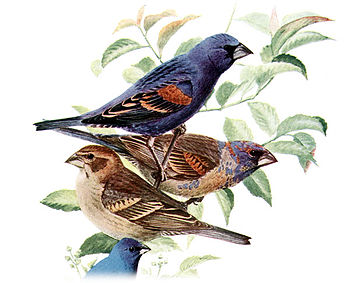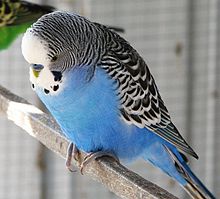- Plumage
-
 The differences in plumage of a Blue Grosbeak, from top to bottom, between a breeding male (alternate plumage) a non-breeding male (basic plumage), a female and a related Indigo Bunting
The differences in plumage of a Blue Grosbeak, from top to bottom, between a breeding male (alternate plumage) a non-breeding male (basic plumage), a female and a related Indigo Bunting
Plumage refers both to the layer of feathers that cover a bird and the pattern, colour, and arrangement of those feathers. The pattern and colours of plumage vary between species and subspecies and can also vary between different age classes, sexes, and season. Within species there can also be a number of different colour morphs. Differences in plumage are used by ornithologists and birdwatchers in order to distinguish between species and collect other species specific information.
Contents
Humphrey-Parkes (H-P) moult and plumage terminology
Almost all species of birds moult at least annually, usually after the breeding season, known as the pre-basic moult. This resulting covering of feathers, which will last either until the next breeding season or until the next annual moult, is known as the basic plumage. Many species undertake another moult prior to the breeding season known as the pre-alternate moult, the resulting breeding plumage being known as the alternate plumage or nuptial plumage. The alternate plumage is often brighter than the basic plumage, for the purposes of sexual display, but may also be cryptic in order to hide incubating birds that might be vulnerable on the nest.[1]
The Humphrey-Parkes terminology requires some attention to detail to name moults and plumages correctly.[2]
Eclipse plumage
Many ducks have bright, colourful plumage, exhibiting strong sexual dimorphism to attract the females. However, they moult into a dull plumage in the non-breeding season. This drab female-like appearance is the eclipse plumage. When they shed feathers to go into eclipse, the ducks become flightless for a short period of time. Some duck species remain in eclipse for one to three months in the summer, while other would retain the cryptic plumage until the next spring when they undergo another moult to return to their breeding plumage. Although mainly found in the Anatidae, a few other species (for example the Red Junglefowl) also have an eclipse plumage.
Abnormal plumages
 Axanthic budgerigar
Axanthic budgerigar
There are hereditary as well as non-hereditary variations in plumage that are rare and termed as abnormal or aberrant plumages. Albinism involves loss of colour in all parts including the iris of the eyes, bills, skin, legs and feet. It is usually the result of a genetic mutation causing the absence of tyrosinase, an enzyme essential for melanin synthesis. Albino adults are rare in the wild because their eyesight is poor resulting in greater risk of predation.[3] Leucism (which includes what used to be termed as "partial albinism") refers to loss of pigments in some or all parts of feathers. Melanism refers to an excess of black or dark colours. Erythromelanism or erythrism is the result of excessive reddish brown erythromelanin deposition in feathers that normally lack melanin. Melanin of different forms combine with xanthophylls to produce colour mixtures and when this combination is imbalanced it produces colour shifts that are termed as schizochroisms (including xanthochromism – overabundance of yellow – and axanthism – lack of yellow – which are commonly bred in cagebirds such as budgerigars). A reduction in eumelanin leads to non-eumelanin schizochroism with an overall fawn plumage while a lack of phaeomelanin results in grey coloured non-phaeomelanin schizochroism. Carotenism refers to abnormal distribution of carotenoid pigments.
The term "dilution" is used for situations where the colour is of a lower intensity overall; it is caused by decreased deposition of pigment in the developing feather, and can thus not occur in structural coloration (i.e. "dilute blue" does not exist); pale structural colors are instead achieved by shifting the peak wavelength at which light is refracted[citation needed]. Dilution regularly occurs in normal plumage (grey, buff, pink and cream colours are usually produced by this process), but may in addition occur as an aberration (e.g. all normally black plumage becoming grey).[4]
In some birds – many true owls (Strigidae), some nightjars (Caprimulgidae) and a few cuckoos (Cuculus and relatives) being widely known examples – there is colour polymorphism. This means that two or more colour variants are numerous within their populations during all or at least most seasons and plumages; in the above-mentioned examples a brown (phaeomelanin) and grey (eumelanin) morph exist, termed "hepatic form" particularly in the cuckoos. Other cases of natural polymorphism are of various kinds; many are melanic/nonmelanic (some paradise-flycatchers, Terpsiphone, for example), but more unusual types of polymorphism exist – the face colour of the Gouldian Finch (Erythrura[verification needed] gouldiae) or the courtship types of male Ruffs (Philomachus pugnax).
References
- ^ Humphrey, P.S. and K.C. Parkes. 1959. An approach to the study of molts and plumages. Auk 76: 1-31 PDF
- ^ Sievert Rohwer, Christopher W. Thompson and Bruce E. Young. 1991 Clarifying the Humphrey-Parkes Molt and Plumage Terminology. Condor 94(1): 297-300 PDF
- ^ Grouw, Hein van (2006). "Not every white bird is an albino: sense and nonsense about colour aberrations in birds". Dutch Birding 28: 79–89. http://www.vogelringschier.nl/DB28%282%2979-89_2006.pdf.
- ^ Buckley, P.A. 1982. Avian Genetics. In: Petrak, M. (ed.). Diseases of cage and aviary birds, 2nd ed. Pags. 21-110. Lea and Febiger, Philadelphia.
Categories:- Bird anatomy
- Feathers
Wikimedia Foundation. 2010.
